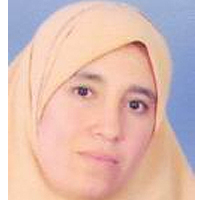Abstract
Research Article
Fallow Lands of Tuva (Russia): 30 years of Steppe Demutation
Makunina NI*
Published: 27 October, 2023 | Volume 7 - Issue 3 | Pages: 113-117
Tuva has been a cattle-breeding region since ancient times, extremely continental climate of this region is little suitable for agriculture. However, the steppes of intermountain depressions in Tuva were heavily plowed by the early 1980s. In the 1990s most of the arable lands were abandoned; the process of restoration (demutation) of natural vegetation on fallow lands began. By now, 30 years later, the old fallows are expected to achieve the stage of the secondary steppe.
The purpose of this work is to estimate the differences between virgin steppes and corresponding secondary steppes in Tuva. Tussock, hummock, and desert virgin steppes have been compared with corresponding to three types of 30-year-old fallow communities. For this study, 330 geobotanical releves have been used. The criteria for comparison have been chosen as follows: the similarity of species composition, the spectrum of dominant species, species richness, grass cover, and grass height. The statistical validity of their differences has been verified. According to these criteria, virgin steppes and their 30-year-old fallow derivatives are shown to differ significantly.
Read Full Article HTML DOI: 10.29328/journal.jpsp.1001115 Cite this Article Read Full Article PDF
Keywords:
Virgin steppe; Secondary steppe; Old fallow; Demutation; Tuva
References
- Frühauf M, Meinel T, Schmidt G. The virgin lands campaign (1954–1963) Until the breakdown of the Former Soviet Union (FSU): with special focus on Western Siberia. In Frühauf M, Guggenberger G, Meinel T, Theesfeld I, Lentz S. (eds) KULUNDA: climate-smart agriculture. Innovations in landscape research. Springer. 2020. https://doi.org/10.1007/978-3-030-15927-6_8.
- Ioffe G, Nefedova T, Zaslavsky I. From spatial continuity to fragmentation: the case of Russian farming. Annals of the Association of American Geographers. 2004; 94:913–943. https://doi.org/10.1111/j.1467–8306.2004.00441.x
- Henebry GM. Global change: Carbon in idle croplands. Nature. 2009 Feb 26;457(7233):1089-90. doi: 10.1038/4571089a. PMID: 19242461.
- Kamp J. Land management: Weighing up reuse of Soviet croplands. Nature. 2014 Jan 23;505(7484):483. doi: 10.1038/505483d. PMID: 24451529.
- Kraemer R, Prishchepov AV, Müller D, Kuemmerle T, Radeloff VC, Dara A, Terekhov A, Frühauf M. Long-term agricultural land-cover change and potential for cropland expansion in the former Virgin Lands area of Kazakhstan. Environmental Research Letters. 2015; 10(5):054012. https://doi.org/10.1088/1748–9326/10/5/054012
- Cherepanov SK. The structure of plant communities of fallow land in the system of protective forest plantations in dry steppes. Arid ecosystems. 2016; 22(1):85.
- Kholboeva SA. Flora and vegetation of the fallows of the valley of the Chikoi River (Western Transbaikalia). In Problems of studying of the vegetation cover of Siberia. Tomsk State University Publishing House. 2017.
- Lesiv M, Schepaschenko D, Moltchanova E, Bun R, Dürauer M, Prishchepov AV, Schierhorn F, Estel S, Kuemmerle T, Alcántara C, Kussul N, Shchepashchenko M, Kutovaya O, Martynenko O, Karminov V, Shvidenko A, Havlik P, Kraxner F, See L, Fritz S. Spatial distribution of arable and abandoned land across former Soviet Union countries. Sci Data. 2018 Apr 3; 5:180056. doi: 10.1038/sdata.2018.56. PMID: 29611843; PMCID: PMC5881411.
- Atutova ZV. The current state of fallow lands in the Tunka depression (Southwestern Cisbaikalia). Geography and Natural Resources. 2020; 41:141-150.
- Azarenko MA, Kazeev KS, Yermolayeva OY, Kolesnikov SI. Changes in the plant cover and biological properties of chernozems in the postagrogenic period. Eurasian Soil Science. 2020; 53:1645-1654.
- Levykin SV, Chibilev AA, Kochurov BI, Kazachkov GV. Towards a strategy for the conservation and restoration of steppes and environmental management in the post-virgin land space. Bulletin of the Russian Academy of Sciences. Geographical series. 2020; 84(4):626-636.
- Levykin SV, Chibilev AA, Ulyanov YA, Kazachkov GV, Yakovlev IG, Nurushev MZ. The virgin land mega project and the land reform as the global experiment of steppe self-restoration in North Eurasia. In IOP Conference Series: Earth and Environmental Science. 2021; 817(1):012058.
- Novikova LA. Demutation of meadow steppes of the Volga upland in protected conditions. Samara Scientific Bulletin. 2020; 9(3):100-106.
- Tokhtar VK, Zelenkova VN. Classification of flora of agrophytocenoses growing in the southwest of the Central Russian Upland (Russia). Plant Cell Biotechnology and Molecular Biology. 2020; 78-85.
- Volkova EM, Rozova IV. Diversity of vegetation on the fallows of Kulikov field (Tula region). Bulletin of Tula State University. Natural Sciences. 2020; 3:12-26.
- Pazur R, Prishchepov AV, Myachina K, Verburg PH, Levykin S, Ponkina EV, Kazachkov G, Yakovlev I, Akhmetov R, Rogova N, Bürgi M. Restoring steppe landscapes: patterns, drivers, and implications in Russia’s steppes. Landscape ecology. 2021; 36:407-425. https://doi.org/10.1007/s10980-020-01174-7
- Kazanovsky SG, Dorofeev NV, Zorina S Yu, Sokolova LG. Vegetation of fallow of different ages in the forest-steppe zone of the Baikal region. Problems of Botany of Southern Siberia and Mongolia. 2022; 21(2):54-58.
- Botvich I, Pisman T, Kononova N, Shevyrnogov A. Seasonal dynamics of fallow land vegetation in Krasnoyarsk forest-steppe according to ground and satellite data. Issledovanie Zemli iz kosmosa. 2018; 6:39-51.
- Kutkina NV, Eremina IG. Bioclimatic potential of fallow lands of Khakassia. Agrarian science. 2018; 11-12:66-69.
- Kutkina NV, Eremina IG. Demutation and bioproductivity of the fallow in the conditions of the hilly steppe of Khakassia. Bulletin of the Krasnoyarsk State Agrarian University. 2021; 10(175):3-10.
- Botvich IYu, Zorkina TM. Dynamics of vegetation restoration of fallows in the steppe zone of the Republic of Khakassia according to ground and satellite data. Biophysics. 2019; 64(2):409-416.
- Kutkina NV. Restoration of fallow lands in the conditions of the steppe catena of Khakassia. Scientific Life. 2019; 14(10):1584.
- Bakhtin NP. Climate features and agro-climatic resources of Tuva ASSR. Collection of scientific works of the Krasnoyarsk Hydrometeorol. Observatories. 1968; 1:26-68.
- Tiplianova AA, Sambuu AD. [Determinacy and synchronicity of fallow succession in the Tuva steppes]. Izv Akad Nauk Ser Biol. 2014 Nov-Dec;(6):621-30. Russian. PMID: 25739311.
- Gareeva SA, Khusainov AF, Tagirova OV, Giniyatullin RH, Kulagin AYu. Transformation of the vegetation cover of fallows in the vicinity of the natural park "Kandry-Kul" (Republic of Bashkortostan). Agrarian Russia. 2022; 9:34-40.
- Semenova-Tyan-Shanskaya AM. Restoration of vegetation on steppe fallows in connection with the question of the "passage" of species. Bot. journal. 1953; 6:862-873.
- Oorzhak AV, Kuular MM, Namzalov BB, Dubrovskiy NG. Fallow vegetation of Tuva (flora, phytocenology, structural and functional organization). Kyzyl: Tuva State University Publishing House. 2018.
- Titlyanova AA, Sambuu AD. Succession in grasslands. Novosibirsk: SB of RAS Publishing House. 2016.
- Makunina NI, Sambuu AD. Structure and stock of phytomass as indicators of the stage of demutation of steppe fallow lands in Tyva. Russian Journal of Ecology. 2022; 53(5):357-365. https://doi.org/10.1134/S106741362205006X
- Kuminova AV. Weed, fallow, and garbage vegetation. In Vegetation cover and natural forage lands of the Tuva ASSR. Novosibirsk: Nauka Publishing House. 1985.
- Dubrovskiy NG, Oorzhak AV, Namzalov BB. Steppes and abandoned lands of Tuva. Kyzyl: Tuva State University Publishing House.
- Dubrovsky NG, Namzalov BTs. B, Oorzhak AV, Kuular MM. Floristic-geobotanical and bioecological studies of the fallow vegetation of Tuva. Bulletin of Buryat State University. Biology. Geography. 2018; 1:27-43.
- Sambuu AD. Secondary successions of phytocenoses in steppe ecosystems of Tuva. 2022.
- Hammer Ø. PAST: Paleontological Statistics, Version 3.0. Natural History Museum University of Oslo. 2013.
- Guo X, Cui X, Li H. Effects of fillers combined with biosorbents on nutrient and heavy metal removal from biogas slurry in constructed wetlands. Sci Total Environ. 2020 Feb 10; 703:134788. doi: 10.1016/j.scitotenv.2019.134788. Epub 2019 Nov 3. PMID: 31733500.
- Elith J, Leathwick JR. Species distribution models: ecological explanation and prediction across space and time. Annual Rev. Ecol. Evol. Systematics. 2009; 40(1):677–697. https://doi.org/1146/annurev.ecolsys.110308.120159
Figures:

Figure 1
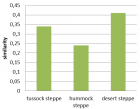
Figure 2
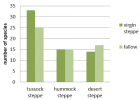
Figure 3
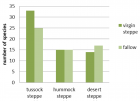
Figure 4
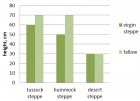
Figure 5
Similar Articles
-
Fallow Lands of Tuva (Russia): 30 years of Steppe DemutationMakunina NI*. Fallow Lands of Tuva (Russia): 30 years of Steppe Demutation. . 2023 doi: 10.29328/journal.jpsp.1001115; 7: 113-117
Recently Viewed
-
The Immunitary role in chronic prostatitis and growth factors as promoter of BPHMauro luisetto*,Behzad Nili-Ahmadabadi,Ghulam Rasool Mashori,Ram Kumar Sahu,Farhan Ahmad Khan,Cabianca luca,Heba Nasser. The Immunitary role in chronic prostatitis and growth factors as promoter of BPH. Insights Clin Cell Immunol. 2018: doi: 10.29328/journal.icci.1001003; 2: 001-013
-
Huge median prostatic lobe: a interesting case of BPHBabty Mouftah*,Slaoui Amine,Fouimtizi Jaafar,Mamad Ayoub,Karmouni Tarik,El Khadder Khalid,Koutani Abdellatif,Ibn Attya Ahmed. Huge median prostatic lobe: a interesting case of BPH. J Clin Med Exp Images. 2022: doi: 10.29328/journal.jcmei.1001026; 6: 006-006
-
Prostate health in India (BPH & Prostate Cancer)Suresh Kishanrao*. Prostate health in India (BPH & Prostate Cancer). Arch Cancer Sci Ther. 2022: doi: 10.29328/journal.acst.1001028; 6: 009-017
-
Coexistence of common gallstones and sinusoidal obstruction syndrome: Case report and review of the literatureFurkan Karahan*,Nihan Acar,Arzu Avcı,Osman Nuri Dilek. Coexistence of common gallstones and sinusoidal obstruction syndrome: Case report and review of the literature. Arch Surg Clin Res. 2021: doi: 10.29328/journal.ascr.1001060; 5: 020-022
-
Scientific Analysis of Eucharistic Miracles: Importance of a Standardization in EvaluationKelly Kearse*,Frank Ligaj. Scientific Analysis of Eucharistic Miracles: Importance of a Standardization in Evaluation. J Forensic Sci Res. 2024: doi: 10.29328/journal.jfsr.1001068; 8: 078-088
Most Viewed
-
Evaluation of Biostimulants Based on Recovered Protein Hydrolysates from Animal By-products as Plant Growth EnhancersH Pérez-Aguilar*, M Lacruz-Asaro, F Arán-Ais. Evaluation of Biostimulants Based on Recovered Protein Hydrolysates from Animal By-products as Plant Growth Enhancers. J Plant Sci Phytopathol. 2023 doi: 10.29328/journal.jpsp.1001104; 7: 042-047
-
Sinonasal Myxoma Extending into the Orbit in a 4-Year Old: A Case PresentationJulian A Purrinos*, Ramzi Younis. Sinonasal Myxoma Extending into the Orbit in a 4-Year Old: A Case Presentation. Arch Case Rep. 2024 doi: 10.29328/journal.acr.1001099; 8: 075-077
-
Feasibility study of magnetic sensing for detecting single-neuron action potentialsDenis Tonini,Kai Wu,Renata Saha,Jian-Ping Wang*. Feasibility study of magnetic sensing for detecting single-neuron action potentials. Ann Biomed Sci Eng. 2022 doi: 10.29328/journal.abse.1001018; 6: 019-029
-
Pediatric Dysgerminoma: Unveiling a Rare Ovarian TumorFaten Limaiem*, Khalil Saffar, Ahmed Halouani. Pediatric Dysgerminoma: Unveiling a Rare Ovarian Tumor. Arch Case Rep. 2024 doi: 10.29328/journal.acr.1001087; 8: 010-013
-
Physical activity can change the physiological and psychological circumstances during COVID-19 pandemic: A narrative reviewKhashayar Maroufi*. Physical activity can change the physiological and psychological circumstances during COVID-19 pandemic: A narrative review. J Sports Med Ther. 2021 doi: 10.29328/journal.jsmt.1001051; 6: 001-007

HSPI: We're glad you're here. Please click "create a new Query" if you are a new visitor to our website and need further information from us.
If you are already a member of our network and need to keep track of any developments regarding a question you have already submitted, click "take me to my Query."



















